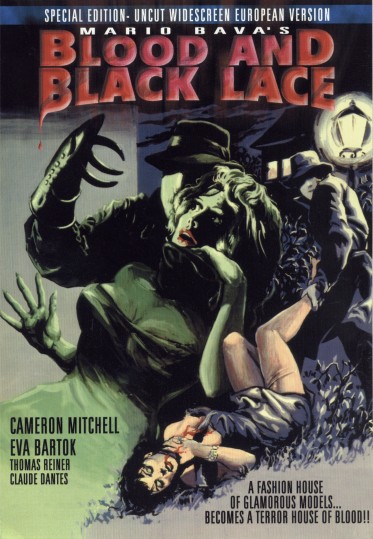 BLOOD
AND BLACK LACE (1964)
BLOOD
AND BLACK LACE (1964)Director: Mario Bava
VCI Home Video
 BLOOD
AND BLACK LACE (1964)
BLOOD
AND BLACK LACE (1964)As the original Italian title translates as "Six Women for the Murderer," Mario Bava inaugurated the "body count" film with the legendary BLOOD AND BLACK LACE. Although the first "giallo" is also credited to Bava with 1963's THE GIRL WHO KNEW TOO MUCH (aka THE EVIL EYE), this time the director uses color--although he was advised not to--and formulates an incredibly visual, sadistic yet beautiful paradigm. Bava set an unrivaled standard for Italian "who done it" thrillers, and countless imitators can be found, even in the American "teen in peril" movement of today.
The plot concerns a series of gruesome slayings surrounding the Haute Couture fashion salon, run by Eva Bartok and Cameron Mitchell. The lovely models are sadistically murdered by a faceless nut that the police deem a "sex maniac." The killer is obsessed with tracking down a red diary, loaded with information about the sorted sexual affairs and drug abuse of the various models. One by one, the girls are viciously tortured and killed, while most of the male cast is held suspect by a fervent police inspector (Thomas Reiner).
Made for roughly $150,000, BLOOD AND BLACK LACE was an Italian/German co-production, and the German co-producers probably wanted Bava to deliver an Edgar Wallace-style thriller, which were very popular at the time. Instead, Bava delivers a far superior film, substituting rapid editing with a unique style of long gliding tracking shots and pans, as well as his usual flair for colorful lighting schemes. The murders are grisly, without being overly graphic (much like the barbarous H.G. Lewis films of the same era), and are lensed in a beautiful, almost poetic manner.
Although the film has been released several times on home video in this country, stateside fans have never seen it fully uncut, except for dark, murky bootlegs that have surfaced. The Roan Group released a laserdisc several years ago, but this was still an edited print of The Woolner Brothers' U.S. version culled from a 16mm print. Now, VCI has given the film a marvelous facelift using completely unedited German print sources, and BLOOD AND BLACK LACE finally looks as stunning as it should. Letterboxed at 1.66:1, the Technicolor images--which were shot in Eastmancolor--now have incredible clarity, true eye candy for the fan to behold. A brief but poignant shot--in which a cloud of blood mists over Claude Dantes' tub-drowned corpse--is now thankfully restored.
As would be expected, VCI's wonderful transfer is complimented by a rewarding array of extras. Video Watchdog's Tim Lucas, who also did the commentaries for Image's BLACK SUNDAY and VCI's THE WHIP AND THE BODY, gives his best chat yet. Again, Lucas' research results in a bevy of facts (I was amazed to discover that Paul Frees did the English dubbing for most of the male cast members) and anecdotes, many taken from interviews that he conducted with various cast members himself.
Mary Dawne Arden, an American actress who starred as one of the murdered models, was located for a rare interview. Arden talks pleasantly about working on the film (without bitterness, she claims she wasn't even paid for it!), and updates us on her varied non-acting career and what she's doing today. There's also an interview with Cameron Mitchell, conducted by David De Valle on a public access talk show, a few years before the actor's death in 1994. Mitchell--a confirmed defender of Bava's brilliance--shows his good sense of humor ("Mario, wherever you are, you son of a bitch, I love you!") and his appreciation for their body of work together.
The Dolby Digital mono sound is offered in English, French or Italian with removable English or Spanish subtitles. There is also a nice still gallery, three different trailers for the film, trailers for other Bava films, and a bonus soundtrack, culled from the original album. Please note that VCI's disc of BLOOD AND BLACK LACE has had trouble playing in some players, notably several Pioneer and Panasonic models, so you might want to contact them if you have trouble with your disc. (George R. Reis)